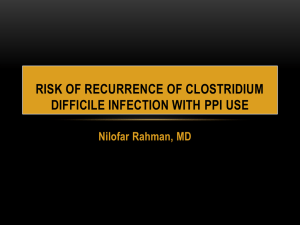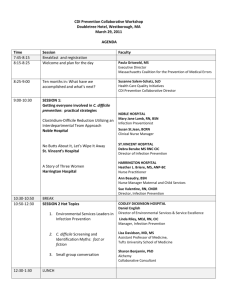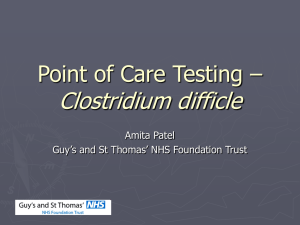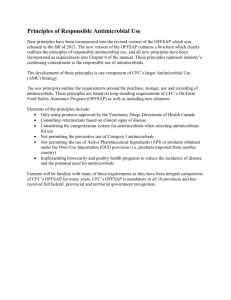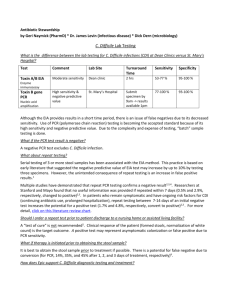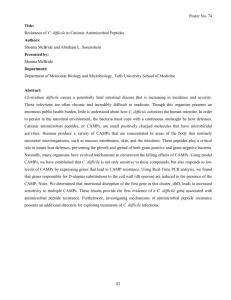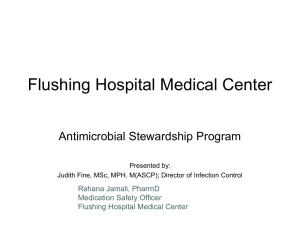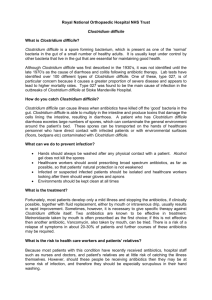Clostridium difficile infection - which
advertisement
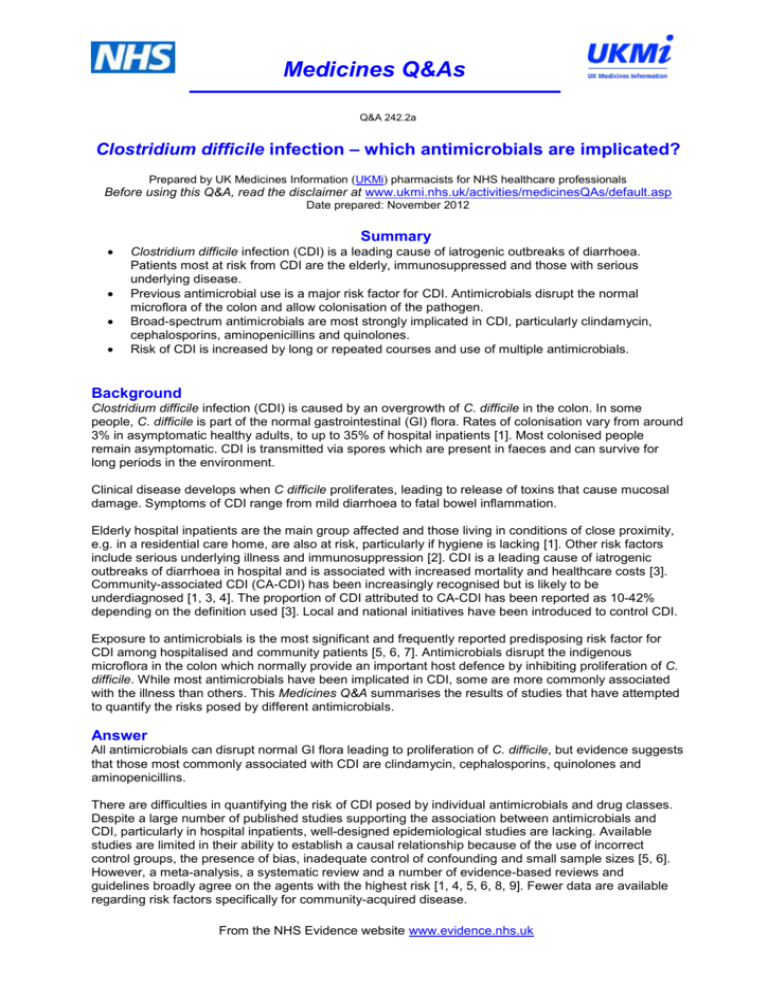
Medicines Q&As Q&A 242.2a Clostridium difficile infection – which antimicrobials are implicated? Prepared by UK Medicines Information (UKMi) pharmacists for NHS healthcare professionals Before using this Q&A, read the disclaimer at www.ukmi.nhs.uk/activities/medicinesQAs/default.asp Date prepared: November 2012 Summary Clostridium difficile infection (CDI) is a leading cause of iatrogenic outbreaks of diarrhoea. Patients most at risk from CDI are the elderly, immunosuppressed and those with serious underlying disease. Previous antimicrobial use is a major risk factor for CDI. Antimicrobials disrupt the normal microflora of the colon and allow colonisation of the pathogen. Broad-spectrum antimicrobials are most strongly implicated in CDI, particularly clindamycin, cephalosporins, aminopenicillins and quinolones. Risk of CDI is increased by long or repeated courses and use of multiple antimicrobials. Background Clostridium difficile infection (CDI) is caused by an overgrowth of C. difficile in the colon. In some people, C. difficile is part of the normal gastrointestinal (GI) flora. Rates of colonisation vary from around 3% in asymptomatic healthy adults, to up to 35% of hospital inpatients [1]. Most colonised people remain asymptomatic. CDI is transmitted via spores which are present in faeces and can survive for long periods in the environment. Clinical disease develops when C difficile proliferates, leading to release of toxins that cause mucosal damage. Symptoms of CDI range from mild diarrhoea to fatal bowel inflammation. Elderly hospital inpatients are the main group affected and those living in conditions of close proximity, e.g. in a residential care home, are also at risk, particularly if hygiene is lacking [1]. Other risk factors include serious underlying illness and immunosuppression [2]. CDI is a leading cause of iatrogenic outbreaks of diarrhoea in hospital and is associated with increased mortality and healthcare costs [3]. Community-associated CDI (CA-CDI) has been increasingly recognised but is likely to be underdiagnosed [1, 3, 4]. The proportion of CDI attributed to CA-CDI has been reported as 10-42% depending on the definition used [3]. Local and national initiatives have been introduced to control CDI. Exposure to antimicrobials is the most significant and frequently reported predisposing risk factor for CDI among hospitalised and community patients [5, 6, 7]. Antimicrobials disrupt the indigenous microflora in the colon which normally provide an important host defence by inhibiting proliferation of C. difficile. While most antimicrobials have been implicated in CDI, some are more commonly associated with the illness than others. This Medicines Q&A summarises the results of studies that have attempted to quantify the risks posed by different antimicrobials. Answer All antimicrobials can disrupt normal GI flora leading to proliferation of C. difficile, but evidence suggests that those most commonly associated with CDI are clindamycin, cephalosporins, quinolones and aminopenicillins. There are difficulties in quantifying the risk of CDI posed by individual antimicrobials and drug classes. Despite a large number of published studies supporting the association between antimicrobials and CDI, particularly in hospital inpatients, well-designed epidemiological studies are lacking. Available studies are limited in their ability to establish a causal relationship because of the use of incorrect control groups, the presence of bias, inadequate control of confounding and small sample sizes [5, 6]. However, a meta-analysis, a systematic review and a number of evidence-based reviews and guidelines broadly agree on the agents with the highest risk [1, 4, 5, 6, 8, 9]. Fewer data are available regarding risk factors specifically for community-acquired disease. From the NHS Evidence website www.evidence.nhs.uk The meta-analysis, which included 49 published studies, ranked individual antimicrobials in relation to the risk of CDI and gave a quantitative assessment of the risk by providing pooled odds ratios (OR) [8]. This analysis has been criticised on the basis that the included studies are too different to lend themselves to meta-analytic techniques [6]. In some instances, the confidence intervals of the quoted ORs are wide and overlapping and the robustness of results are questionable but of interest in the context of other reviews. The analysis reported an overall, statistically significant positive association between antimicrobial use and CDI (pooled OR 5.9; [95% CI 4.0 to 8.5]). The cited odds ratios for commonly-used agents ranged from 1.3 [0.1 to 19.6] for tetracyclines to 36.2 [19.0 to 68.9] for cefotaxime. The odds ratios were highest for broad-spectrum agents such as cefotaxime (see above), ceftazidime (28.8 [12.7 to 65.1]), amoxicillin in combination with a beta-lactamase inhibitor (22.1 [6.5 to 75.4]), and nitrofurantoin (26.5 [2.7-262.1]). A systematic review also reported a positive association between overall antimicrobial use and hospitalacquired CDI with odds ratios ranging from 2.86 to 6.92 in studies that used appropriate controls [6]. Two studies considered to be of reasonable quality showed an increased risk for CDI associated with clindamycin (OR 4.22; [95% CI 2.11 to 8.45]), cephalosporins (relative risk (RR) 2.07; [1.06 to 6.62]) and penicillins (RR 3.62; [1.28 to 8.42]). A recently published evidence-based review used data from the above systematic review and one other study to calculate crude numbers needed to harm (NNH) for different antimicrobials associated with CDI [9]. Those associated with the highest risk were clindamycin (NNH=8), penicillins (NNH=9) and quinolones (NNH=10), followed by cephalosporins (NNH=21). Other factors associated with an increased risk of CDI are long duration of antimicrobial treatment, use of multiple courses of antimicrobials and use of combination antimicrobials [5, 9, 10]. However, even limited exposure, such as single-dose prophylaxis prior to surgical procedures is associated with increased risk [5, 10]. There are fewer studies of CA-CDI than hospital-acquired infection and robust data are limited by methodological issues [7]. Antibiotic exposure and previous hospital admission remain the strongest risk factors, although there is increasing awareness of CA-CDI in patients lacking traditional risk factors of antibiotic exposure or hospital admission and in groups previously considered to be at low-risk (e.g. children, young adults and pregnant women) [3, 7]. A small UK prospective, case-controlled study of CDI cases presenting in the community, found significantly more cases than controls had antimicrobial exposure in the previous four weeks, (52% vs. 18%, p=0.001), particularly aminopenicillins (p=0.02), oral cephalosporins (p=0.045) and multiple agents (p<0.001). Hospitalisation in the previous six months was also a significant risk factor (45% vs. 23%, p=0.022) but interestingly 35% of cases had neither exposure to antimicrobials or recent hospitalisation [7]. A recent US population-based, retrospective case-control study found that CA-CDI cases (defined as CDI diagnosis in the community or on hospital admission, with no history of hospital discharge in the previous 12 weeks) were more likely than controls to have received antimicrobials in the 180 days before diagnosis (adjusted OR, 6.09 [4.59 to 8.08]). Adjusted odds ratios were highest for clindamycin (13.00 [7.03 to 24.04]), beta-lactam/beta-lactamase inhibitors (5.10 [3.26 to 8.00]), fluoroquinolones (4.91 [3.28 to 7.35]) and cephalosporins (3.11 [2.17 to 4.45]), and the risk was highest during the first 30 days after antimicrobial exposure (13.02 (9.37 to 18.09). However, 27% of CA-CDI cases had no antimicrobial exposure and 17% did not have traditional risk factors for CDI [11]. A systematic-review that reports CA-CDI not to be associated with antimicrobial exposure in 53% of cases has been published in abstract form only and should be interpreted with caution [12]. Reducing CDI risk The risk of CDI associated with specific antimicrobials has changed over time, reflecting different patterns of antimicrobial use. In the US, a clear association with clindamycin in the 1970s led to decreased use and lower rates of CDI; during the 1980s and1990s, third-generation cephalosporins, which were very widely used, had the largest attributable risk [13]. More recently quinolones, which had previously not been associated with CDI, have been strongly implicated in outbreaks of the infection [5]. Medicines Q&A 242.2a November 2012 Clostridium difficile infection – which antimicrobials are implicated? From the NHS Evidence website www.evidence.nhs.uk Antimicrobial stewardship programmes that limit use of specific antimicrobials have been associated with reduced CDI in inpatient studies and are recommended in the UK and US [4, 10, 14, 15, 16]. National initiatives to promote rational use of antimicrobials make the following recommendations [4, 16]: Use narrow-spectrum antimicrobials for empirical treatment where possible. Restrict broad-spectrum antibiotics to patients whose clinical and microbiological test results indicate use is necessary. Avoid using clindamycin and second- and third-generation cephalosporins, especially in the elderly. Minimise use of quinolones, carbapenems and prolonged courses of aminopenicillins. Only prescribe antimicrobials when there is clinical evidence of bacterial infection; the reason for administering antimicrobials should be clearly recorded in the clinical record. Stop antimicrobials started inappropriately or without sufficient evidence, and where microbiology results do not support the diagnosis of bacterial infection. Advice to ‘complete the course’ in such circumstances is no longer acceptable. Establish multidisciplinary Antimicrobial Management Teams (AMT) within Trusts to develop prescribing guidelines and programmes to monitor antimicrobial use. Limitations The results of studies of antimicrobial use and C. difficile infection may be affected by confounding factors. Data for community-acquired infection are limited. References 1. Shannon-Lowe J, Matheson NJ, Cooke FJ and Aliyu SH. Prevention and medical management of Clostridium difficile infection. BMJ 2010; 340: 641-646. 2. Health Protection Agency. Clostridium difficile fact sheet. February 2009. Accessed at www.hpa.org.uk/webc/HPAwebFile/HPAweb_C/1236069362364 on 25/6/2012. 3. Khanna S and Pardi DS. The growing incidence and severity of Clostridium difficile infection in inpatient and outpatient settings. Expert Rev Gastroenterol Hepatol 2010; 4(4): 409-416. 4. Department of Health. Clostridium difficile infection: how to deal with the problem. December 2008. Accessed at www.dh.gov.uk/prod_consum_dh/groups/dh_digitalassets/documents/digitalasset/dh_093218.p df on 25/6/2012. 5. Owens RC, Donskey CJ, Gaynes RP et al. Antimicrobial-associated risk factors for Clostridium difficile infection. Clin Infect Dis 2008; 46: S19-31. 6. Thomas C, Stevenson and Riley TV. Antibiotics and hospital-acquired Clostridium difficileassociated diarrhoea: a systematic review. J Antimicrob Chemother 2003; 51: 1339-1350. 7. Wilcox MH, Mooney L, R Bendall et al. A case-control study of community-associated Clostridium difficile infection. J Antimicrob Chemother 2008; 62: 388-396. 8. Bignardi GE. Risk factors for Clostridium difficile infection. J Hosp Infect 1998; 40: 1-15. 9. Fashner J, Garcia M, Ribble L and Crowell K. What risk factors contribute to C. difficile diarrhea? J Fam Practice 2011; 60(9): 545-547. 10. Cohen SH, Gerding DN, Johnson S et al. Clinical practice guidelines for Clostridium difficile infection in adults: 2010 update by the Society for Healthcare Epidemiology of America (SHEA) and the Infectious Diseases Society of America (IDSA). Infect Control Hosp Epidemiol 2010; 31: 431-455. 11. Kuntz JL, Chrischilles EA, Pendergast JF et al. Incidence of and risk factors for communityassociated Clostridium difficile infection: a nested case-control study. BMC Infect Dis 2011; 11: 194. 12. Bessissow T, Dial S and Lalonde R. Antibiotics and community acquired clostridium difficileassociated diarrhea; a systematic review. Can J Gastroenterol 2009; 23 (Supp SA): poster session 2 (abstract). 13. Blondeau JM. What have we learned about antimicrobial use and the risks for Clostridium difficile-associated diarrhoea? J Antimicrob Chemother 2009; 63: 238-242. 14. Hsu J, Abad C, Dinh M and Safdar N. Prevention of endemic healthcare-associated Clostridium difficile infection: reviewing the evidence. Am J Gastroenterol 2010; 105: 2327-2339. Medicines Q&A 242.2a November 2012 Clostridium difficile infection – which antimicrobials are implicated? From the NHS Evidence website www.evidence.nhs.uk 15. Department of Health. The Health and Social Care Act 2009: Code of Practice on the prevention and control of infections and related guidance. December 2010. Accessed at www.dh.gov.uk/prod_consum_dh/groups/dh_digitalassets/documents/digitalasset/dh_123923.p df on 25/6/2012. 16. Health Protection Agency. Management of infection guidance for primary care for consultation and local adaptation. Reviewed 2010. Accessed at www.hpa.org.uk/webc/HPAwebFile/HPAweb_C/1279888711402 on 25/6/2012. Quality Assurance Prepared by Karoline Brennan, North West Medicines Information Centre Date Prepared November 2012 (Amended December 2012) Checked by Joanne McEntee, North West Medicines Information Centre Date of check November 2012 (Amendment checked December 2012) Search strategy MIDatabank [Clostridium difficile] Medline [CLOSTRIDIUM INFECTIONS/ AND exp ANTI-BACTERIAL AGENTS AND RISK FACTORS/]; [*CLOSTRIDIUM DIFFICILE/ OR *CLOSTRIDIUM INFECTIONS/; AND *COMMUNITY-ACQUIRED INFECTIONS/]. Embase [exp CLOSTRIDIUM DIFFICILE/ AND exp ANTIBIOTIC AGENT/ae AND RISK FACTOR/]; [*CLOSTRIDIUM DIFFICILE INFECTION/ AND exp *ANTIBIOTIC AGENT/]. Cochrane Library [clostridium AND antibiotic*] Health Protection Agency, www.hpa.org.uk [Clostridium difficile] Department of Health, www.dh.gov.uk [Clostridium difficile] Medicines Q&A 242.2a November 2012 Clostridium difficile infection – which antimicrobials are implicated? From the NHS Evidence website www.evidence.nhs.uk

